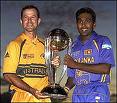Coronary Angiogram, Angioplasty & Stenting
January 10, 2009 35 Comments
About one month ago my uncle (father’s younger brother) had a sudden pain in his heart and got admitted to the hospital. According to doctors’ diagnosis, he has got the heart disease which is called Unstable Angina. This is caused by a block in blood vessels which supply blood into our heart muscles. After one week, my uncle was discharged and back home. But after few days, he was suffering from a breathing difficulty which comes on and off time to time. As this breathing difficulty was increasing, we decided to meet cardiologist, Dr. Vajira Senarathne. His recommendation was to do a Coronary Angiogram which is also known as Coronary Catheterization.
The angiogram was done last monday and I was there. I was amazed by the simplicity and outcome of this technique. An extremely thin catheter is inserted into a blood vessel which goes into the heart. It was inserted from a place near wrist in my uncles case. But sometimes it is done from the upper area of leg as well. This catheter injects a dye into coronary arteries which are the three main vessels that supply oxygen rich blood into our hear muscles. After that, the flow of blood is recorded through a special x-ray technique. The final outcome is a video which shows the flow of blood in coronary arteries. It clearly shows the thickness of flow and it gives a clear idea of which blood vessels got narrowed thickness. Those areas should be treated immediately. Interesting thing is that my uncle even doesn’t know that a catheter was inserted into his body. It is 100% pain less and takes a very short time. He says it was like a simple injection.
Following video shows an example of the output an angiogram.
According to my uncle’s angiogram, he has got a bit long narrowing in one of his three coronary arteries. Doctor’s recommendation is to do a stent treatment. In that also, a catheter is inserted in the same way and the blocked area is cleared using a technique called angioplasty and a metal mesh is kept there to save the artery from blocking again. It gives almost the same result as an open heart bypass surgery with minimum pain and effort. That’s why I was amazed with these new technologies. So we are going to do this treatment for my uncle next week.
The videos given at http://yourtotalhealth.ivillage.com/coronary-angiogram.html provides a perfect idea of angiograms and stenting. You will find it extremely interesting.

